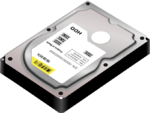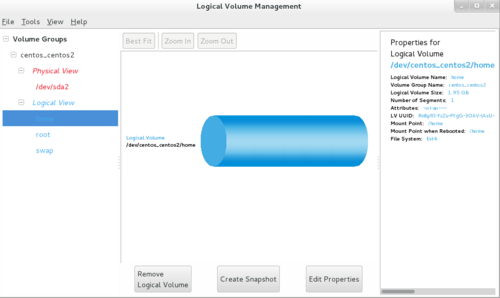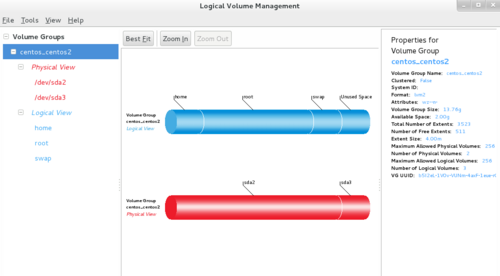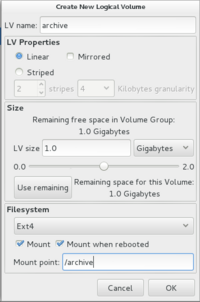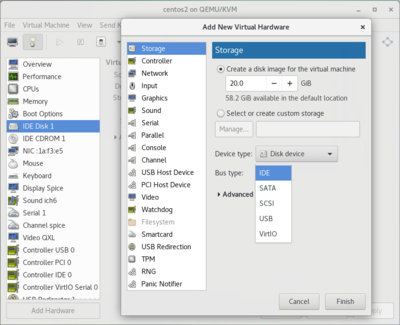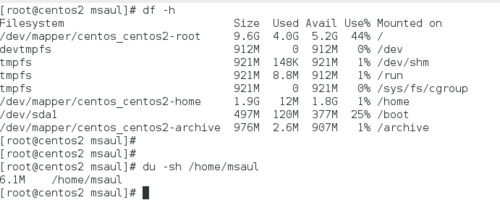OPS235 Lab 5 - CentOS7
Contents
[hide]LAB PREPARATION
Purpose / Objectives of Lab 5
The purpose of this lab is to demonstrate how a Linux system administrator can monitor hard disk space availability, and to manage file system size via the Logical Volume Manager (LVM) application. This lab will also demonstrate how to manually mount (i.e. connect) and unmount (disconnect) partitions to file system directories, and demonstrate how to have partitions automatically mounted to directories upon Linux system startup.
Main Objectives
- Using LVM to resize partitions graphically and via command-line.
- Create, partition and format virtual hard disks to increase the size of a file system.
- Manually connect and disconnect directories (mount points) to existing partitions (mount, umount).
- Monitoring Disk Space (df -h).
- Create a Bash Shell script to monitor and report low disk size (run periodically in crontab).
Minimum Required Materials
My Toolkit (CLI Reference)
| LVM Information: | LVM Management | Miscellaneous |
INVESTIGATION 1: MANAGING FILE-SYSTEMS USING LVM
Monitoring and ensuring adequate space for a Linux file-system is considered to be a critical task for any system administrator. An application called LVM is a very useful tool for Linux system administrators to easily manage file systems - even when the computer system is running!
LVM (Logical Volume Management) is used to manage hard disk drives / partitions for Linux and Unix systems. LVM provides more flexibility than just partitioning hard disks. Volume Groups are areas used to define Physical Volumes (i.e. hard disks, disk partitions, or other forms of storage devices). Logical Volumes are then used to relate directories (mount points) to a specific physical volume or for a "range" or "span" of physical volumes.
LVM allows more flexibility and growth potential for Linux systems (for example, having Logical volumes span multiple hard disks). CentOS uses LVM by default upon installation. Other Linux distributions may provide the capacity to install LVM,
Part 1: Manage LVM Graphically
- Let's learn to administer (manage) our LVM graphically for our centos2 Virtual Machine.
- Launch your centos2 VM and open a shell terminal.
- CentOS provides a tool called system-config-lvm to graphically administer LVM.
NOTE: This tool may be replaced by a future graphical LVM management tool and is NOT currently available in the default repositories. We will now perform a "work-around" in order to make the system-config-lvm utility work in our system. - Issue the following command to download the system-config-lvm rpm:
wget https://kojipkgs.fedoraproject.org//packages/system-config-lvm/1.1.18/1.fc19/noarch/system-config-lvm-1.1.18-1.fc19.noarch.rpm
(Although it is an rpm file for the Fedora Distribution, it will also work for Centos7). - Make certain that you are logged in as root.
- Try issuing the command:
rpm -i ./system-config-lvm-1.1.18-1.fc19.noarch.rpm
You should notice an error. - Use the yum install command to resolve the following dependencies:
yum install gnome-python2-bonoboyum install gnome-python2-gnomeyum install usermode-gtk
- Re-issue the command:
rpm -i ./system-config-lvm-1.1.18-1.fc19.noarch.rpm
It should work this time. - Run the command:
system-config-lvm - On the left-hand side, you can click on the Volume Group, Physical Volume and Logical Volumes and view their properties on the on the right-hand side.
- Determine the current LVM configuration by clicking on the appropriate element and reading the properties in the right-hand panel -- write down the answers:
- What are the names and sizes of the Volume Group?
- What is the name and size of the Physical Volumes?
- What are the names and sizes of the Logical Volumes?
- Is there any space in the VG which is not allocated to a LV?
- Click on Logical View (i.e. above home, root, swap) and then click Create New Logical Volume button. What happens? Why do you think this happened?
We will now create another partition (/dev/vda3) using the fdisk utility, format this newly-created partition so we can create another logical volume called archive.
- Quit the system-config-lvm application.
- In the terminal as root, issue the command:
ls /dev/vd*
NOTE: If nothing displays, issue the command: ls /dev/sd* and use that device pathname /dev/sda instead.
- Issue the command:
fdisk /dev/vda
(or fdisk /dev/sda if the previous command didn't work) - At the fdisk prompt issue the command: p. What does this do?
- Now issue the commands n (new partition), p (primary partition), 3 (i.e. next available partition number). When prompted for initial block, press enter to accept the default beginning block size, and type: +2G at ending block (create 2GB for partition) and press enter.
- At the fdisk prompt, issue the command p to review the partition information, then type w to save partition table and exit (ignore WARNING message).
- You must restart your centos2 VM to allow changes to take effect
- Open a terminal as root, and format your newly-created partition by issuing the command:
mkfs -t ext4 /dev/vda3
(or mkfs -t ext4 /dev/sda3)
- Restart the system-config-lvm utility. Do you see a new /dev/sda3 partition under Physical Volumes?
- To add the newly created partition, you need to add it into LVM to be used. Exit the system-config-lvm utility and issue the following command to add the partition into LVM:
pvcreate /dev/vda3(or pvcreate /dev/sda3 ) (enter y to proceed - ignore warning) - Restart system-config-lvm. You should notice a section at the bottom indicating Unallocated Physical Volumes. Click on the unallocated partition /dev/vda3 and then click Add to Existing Volume Group (click on other button in next screen to continue). The screen should now show the partition /dev/vda3 contained in our default Volume Group (refer to diagram on right-side for reference).
- Click on Logical View (i.e. above home, root, swap), and then click on Create New Logical Volume button and fill out the details for this new logical volume including: size: 1GB, LV Properties: linear, file system: ext4 file system name: archive, select mount and mount it at: /archive. Have the system create the directory /archive if it does not exist (Refer to diagram on right for reference).
- Confirm that this new Logical Volume now exists by changing to the directory /archive. Did you need to restart your centos2 VM to confirm that the /archive directory is now on your centos2 VM?
- Use system-config-lvm to resize (i.e. edit) the archive logical volume to 1.5 GB and verify your results.
Answer Part 1 observations / questions in your lab log book.
Part 2: Managing LVM Via Command Line & Adding Virtual Hard Drives
Let's say that you have run out of disk space on your centos3 VM, and you need more space on the root file-system in order to host more web-pages, or to support a larger database. What are your options? Getting a replacement hard-drive would probably require re-installation of the operating system and/or backing up and restoring data on the old hard disk.
Because we're using LVM we can avoid this problem. We can add a new virtual hard-drive (which will serve as a physical volume) to the volume group, and extend the root logical volume to make use of the new available space. Creating virtual hard drives is not only inexpensive, but a great way for students to learn now to simulate growing the size of the file system.
Perform the following operations to increase the size of lv_root in centos3:
- Perform this Part in your centos3 VM.
- Run the following commands and make note of the output:
ls /dev/vd*pvsvgslvsdf -h
- Record the size of the volume group and the amount of free space
- At the top of your VM window (make certain not full screen mode) click the view menu and change view from Console to Details .
- At the bottom left-hand corner, click Add Hardware and add a new storage device of 2GBs, make sure the Bus type is selected as: VirtIO disk.
NOTE: Make certain to click "select managed or other existing storage", and fill in the pathname circled in red as shown in the diagram on the right-hand-side. - Go back to the console view
- Issue the command:
ls /dev/vd*, what has changed? - Use fdisk (refer to how to use in Part 1) to create a new single primary partition for /dev/vdb that fills the entire disk, save partition table (accepting defaults prompts would work), restart your centos3 VM and then format that partition for file type: ext4.
- Now we'll make the new device a physical volume, add it to the volume group, and extend lv_root:
-
pvcreate /dev/vdb1(enter y to proceed - ignore warning)
-
-
vgs(to determine: name_of_volumegroup)
-
-
vgextend name_of_volumegroup /dev/vdb1
-
-
lvextend -L +2G -r name_of_volumegroup/lv_root
-
- Now rerun the ls /dev/vd* , pvs , vgs , lvs and df -h commands.
- Record the size of the volume group and the amount of free space. What has changed and what caused those changes?
- Among the changes, note that your root file-system is now 2GB bigger, and you have not even rebooted your machine since you used fdisk to create a partition!
- Reduce the size of the lv_root partition by 1GB by issuing the following command:
lvreduce name_of_volumegroup/lv_root --size -1GConfirm that the file system has been reduced. - Increase the size of the lv_root partition by another 1GB by issuing the command:
lvextend name_of_volumegroup/lv_root --size +1GConfirm that the file system can been increased. - Record the LVM Management commands in your lab log-book.
Answer Part 2 observations / questions in your lab log book.
INVESTIGATION 2: ADDITIONAL FILE-SYSTEM OPERATIONS
We take for granted that a file-system must be mounted (for example the root partition) in order for a Linux system to be usable upon system start-up. This was create automatically for the /archive mount point automatically when we used the system-config-lvm utility in the previous investigation. We need to learn now to do this manually by editing or adding an entry in the /etc/fstab file. The /etc/fstab (file system table) contains entries to mount various file systems automatically upon start-up of the Linux system.
The Linux system administrator also has the ability to manually mount (connect) and un-mount (disconnect) partitions in order to perform maintenance on the file system (for example un-mounting the /home partition to install software and prevent users from logging in during that process).
Part 1: Mounting and Un-mounting Partitions
- Perform this part in your centos2 VM.
- As you may recall in Part 1 of Investigation 1, we created another logical volume called archive using the graphical application system-config-lvm. This logical volume should be mounted (connected) to our existing file-system (2GB).
- Issue the following command:
mount - What is the purposed of issuing this command without arguments? Can you see the /archive mount point?
- Confirm that the directory named /archive is mounted.
- You can use the umount command to unmount a file-system (eg. for maintenance purposes). Note the the name of the command is umount, not unmount.
- Make certain you are not located in the /archive directory, and issue the following command to unmount the /archive directory:
umount /archive - Issue the mount command (without arguments) to confirm it has been unmounted.
- View the contents of the file-system table /etc/fstab by issuing the following command:
cat /etc/fstab - Note the line that automatically mounts a file-system (/dev/sda3, type ext4) to /archive. This was automatically performed for you via the system-config-lvm utility.
- View and record the fields for the /archive mount in your lab logbook, and then issue the following command to reconnect or mount /archive:
mount -t ext4 /dev/centos_centos2/archive /archive
NOTE: If you are having problem mounting, use the /dev pathname listing in your /etc/fstab file. - Confirm that this file-system has been properly mounted. Note: You could have also issued the command: mount -a to automatically mount the file-systems contained in the /etc/fstab file.
Tip: If you had to do manually configure /etc/fstab (eg. only in text-based mode - centos3), you could have issued the command (as root):
echo "/dev/centos_centos2/archive /archive ext4 defaults 1 2" >> /etc/fstab
(although we don't need to do this, since it was already done). - A curious question: If root needs to unmount the /home directory for maintenance but we had to first login in graphically as a regular user, then su to "root", isn't our regular user still logged in so we can't un-mount the /home directory?!? How can we as a Linux System Administrator get around the problem (hint: you already learned it somewhere in lab3!!! Wow, using what we already taught can pay-off in the future ... lol!).
Answer the Part 1 observations / questions in your lab log book.
Part 2: Monitoring Disk Space
Another essential duty of a Linux system administrator is to anticipate problems and take preventative measures to avoid computer system problems before that occur.
Monitoring disk space activity helps provide Linux system administrators information to help take corrective action before problems can occur.
- Remain in your centos2 VM for this section.
- Issue the command:
df -h - Note the disk space usage for /, /home, and /archive partitions.
- If a partition is running out of available space, the Linux System Administrator can reallocate space among partitions or add another disk and grow the file system (like you did in a previous investigation). The administrator also can investigate the cause of low disk space. Two examples immediately come to mind: excessive use of space from users, and potential penetration from hackers.
- To investigate excessive disk usage by regular users, you can obtain a total amount of disk usage for that user by issuing the command:
du -hs /home/regularuserid - To provided a more detailed list of usage (file-by-file), issue the command:
du -h /home/regularuserid | more - If there is a recurring space usage problem with regular users, the Linux system administrator can impose quotas (caps on disk usage). This method is not taught in this course.
- The methods to monitor potential penetration to a Linux system are too numerous, and are taught in other coures (for example: SEC520). On method of monitoring potential penetration is to look for abnormally large files. Issue the command:
find -P / -size +100000k - Did you see any files that are that size?
- The next section will apply some of these tools we have discussed into a shell script and crontab entry to periodically monitor and contact the system administrator of potential disk space issues (before they become a serious problem).
Answer the Part 2 observations / questions in your lab log book.
INVESTIGATION 3: LOOKING AHEAD
Automating Routine Tasks (Scheduling The Running of Shell Script Via Crontab)
This emphasis on this section focuses on how to run useful shell scripts or shell script that we have created at specific dates/times. It would be silly to expect a system administrator to stay up late (eg. 2 a.m.) to manually run a shell script to terminate processes or to re-boot Linux servers. Database files (tables) are used to provide instructions on how frequent shell scripts or commands can be run. The cron daemon is used to refer to these files and to run them on a pre-determined basis. The term cron comes from the old word chronograph meaning a special type of watch (actually a stop-watch) to help monitor and schedule routine tasks.
- Perform this section in your c7host machine
- Make certain you are logged in as root.
- Download, study, and run the following shell script. Issue the command:
wget https://scs.senecac.on.ca/~murray.saul/monitor-disk-space.bash - Try to understand what this Bash Shell script does (refer to man pages for the awk command), and then run the script as root.
In order to automatically run the above-mentioned script periodically, you use the scheduler in Linux called crontab. The term crontab stands for Chronograph Tables, where a chronograph is the old term for a timepiece (the forerunner of the modern watch). You can run the crontab command to schedule commands and shell script to be run in a number of different ways.
- Quickly view the tutorial about the Using crontab file to understand the purpose of this file and how to basically set up a schedule to run a shell script.
- Issue the following command to setup a crontab entry for root:
crontab -e - Enter the following line in order to run at 6:00 on the first day of every month:
0 6 1 * * /root/monitor-disk-space.bash #Runs first day of each month (6:00 am) - Save the crontab entry.
- Confirm that the entry was properly saved by issuing the following command:
crontab -l
Answer Investigation 3 observations / questions in your lab log book.
LAB 5 SIGN-OFF (SHOW INSTRUCTOR)
Arrange proof of the following on the screen:
- ✓ centos2 VM:
- Logical Volume, Physical Volume, and Volume Group information
- Contents of /etc/fstab file
- Proof that /archive has been mounted
- ✓ centos3 VM:
- Proof of virtual hard disk creation
- Logical Volume, Physical Volume, and Volume Group information
- ✓ c7host Machine:
- Proof of creation of the shell script: monitor-disk-space.bash
- Crontab entry for root account
- ✓ Lab5 log-book filled out.
Practice For Quizzes, Tests, Midterm & Final Exam
- What is a VG? PV? LV?
- What is the total size of the "main" VG on your system?
- How do you create an LV?
- How do resize an LV?
- How would you add the disk partition /dev/sdb7 to your volume group "main"?
- How would you increase the size of the root filesystem by 50 MB?
- How can you determine if a partition has been mounted onto a system?
- How can you unmount an existing partition from the file-system?
- How can you temporarily mount a partition on a file-system?
- How can you permanently mount a partition on a file-system upon boot-up?
- What are the separate elements (fields) of the /etc/fstab file?
- Describe the tools that a Linux system administrator have to monitor disk space usage.
